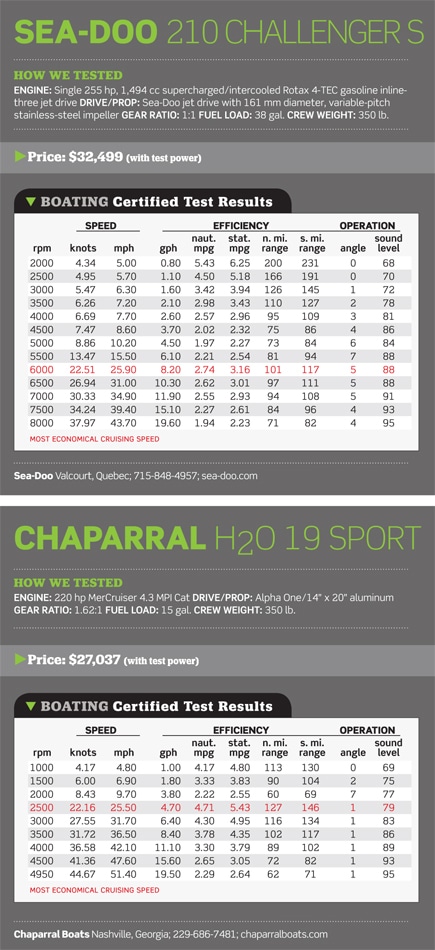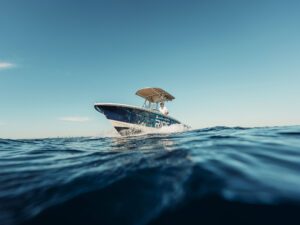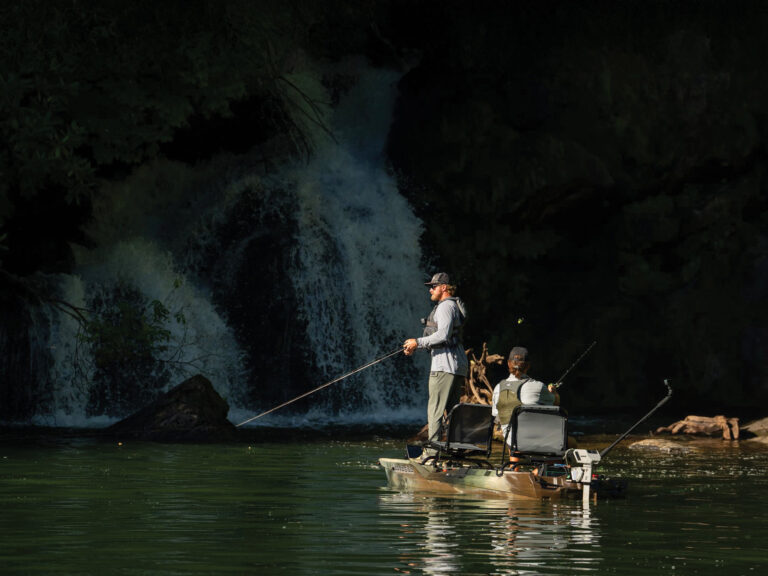Muscling their way onto the market in the early ’90s, “sport jets” jet boats were dismissed as little more than toys, quick and agile playthings, scoffed at by serious boaters. They peaked quickly and then vanished just as fast.
But a funny thing happened on the way to obscurity. Sea-Doo and Yamaha developed bigger, more versatile offerings. Today jet-powered runabouts are the best-selling models in the 24- and 21-foot segments.
To find out why jets are giving sterndrives a run for their money, and to determine if jets are suitable propulsion for experienced boaters, we pitted a Sea-Doo 210 Challenger S featuring a single 255 hp supercharged high-output Rotax jet drive against a Chaparral H2O 19 Sport with a 220 hp MerCruiser sterndrive and put them through their paces.
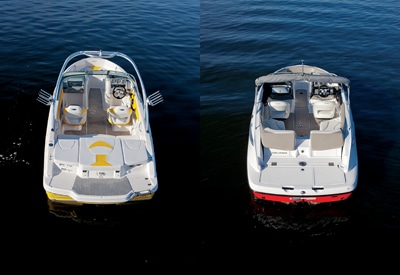
Round 1: Layout
Dock a sterndrive boat and its jet-drive counterpart side by side and the difference is obvious. A sterndrive engine, based on an automotive block, is much heavier and larger. MerCruiser’s 4.3 MPI measures 28 by 30 by 22 inches and tips the scale at 775 pounds without the Alpha sterndrive. By comparison, Sea-Doo’s Rotax is 30 by 21 by 18½ inches and weighs 198 pounds. The sterndrive’s drive shaft exits the hull and then makes two 90-degree turns before linking to the propeller. The drive itself adds 85 pounds to the total. The Sea-Doo drive shaft links directly to the impeller, housed within an enclosed jet pump with integral pivoting nozzle, adding 35 pounds.
The jet’s smaller profile enables boat designers to take liberties unavailable with sterndrives. Most notably, jet boats aren’t forced into a sun pad layout in order to enclose the engine. As aboard the Sea-Doo, this opens up the aft cockpit with low-profile benches and center transom walk-throughs. In contrast, the Chaparral features a sterndrive’s typical sun pad, nice for a passenger wanting to lay out but cumbersome to climb over when boarding. Many sterndrive manufacturers combat this with walk-through passages to the side of the engine, but ultimately a sterndrive takes up a bigger percentage of the boat’s volume.
Layout and boarding ease aside, it’s interesting to note that the shorter, narrower Chaparral (20 feet 6 inches by 7 feet 6 inches) and the longer, beamier Sea-Doo offer almost identical passenger space forward of their platforms. I measured the Sea-Doo as having a 42-inch-long bow cockpit and 90-inch-long main cockpit and the Chaparral a 45-inch-long bow cockpit and 90-inch main cockpit. The big differences are aft of the cockpit. The jet engine’s small size grants Sea-Doo a three-foot-long swim platform, with padded backrests for seating when not under way, and a large stowage locker built into the platform. By contrast, Chaparral takes up nearly the same three feet in sun pad length, followed by a smaller, 20-inch-long platform.

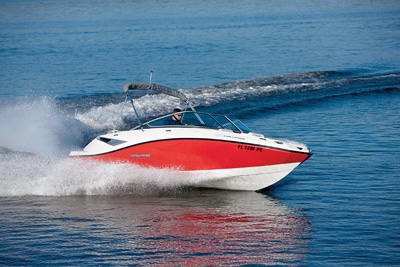
Round 2: Handling
From a “seat of the pants” perspective, a jet produces the most thrilling results at speed. The quick reactions provided by a directional nozzle enable a jet boat to turn quicker and tighter, producing a ride guaranteed to leave the kids giggling and the adults lunging for the grab handles. Using a hard turn around a buoy at 30 mph and recording our track with a chart plotter over several runs, we measured the sterndrive-powered Chaparral’s turning circle consistently wider than the jet-drive-powered Sea-Doo’s. While the jet pump bogged slightly powering out of the tightest turns, the boat turned relatively flat and in control. The sterndrive bucked when attempting to keep the turn as tight as possible, performing best when given a wider arc. Still, we were pleased by the handling prowess of the Chaparral. While the Sea-Doo clearly featured the sportiest handling, the Chaparral fared better than most sterndrives I’ve tested over the last two decades.
While conventional wisdom has always been that jets fail to measure up to sterndrives in low-speed maneuverability, our test revealed that a jet can do well if you learn to exploit its unique characteristics.
With a sterndrive, thrust is guided in the same direction as the rudder. Propeller motion can also be stopped for a true neutral, nice if you want to idle and let go of the controls. In contrast, the jet engine is always pumping water. For neutral or reverse, a shaped gate redirects water flow in the appropriate direction. While a boater accustomed to prop propulsion will find the handling suspect at first, with practice, constant thrust can be used to advantage. The key is to employ minimal input to wheel and throttle. (Sea-Doo actually features a mode that reduces rpm). A boat driven by a single jet can be made to spin within its own length, and as such can even be wiggled sideways into a berth not much longer than its overall length. In short order we were able to dock the jet as well as the sterndrive.Assumption squashed.
The “common knowledge” that sterndrives are better for towing held true. While either choice will be fine for casual enthusiasts, better skiers and wakeboarders will quickly note that, with its lack of rudder in the water, a jet can be pulled off its line by a hard tug on the tow line, requiring frequent corrections at the wheel by the skipper. A jet also creates a good amount of turbulence atop the water, which can affect a rider on a short tow line, and its wakes aren’t as solid and predictable as a sterndrive’s for wakeboarding.

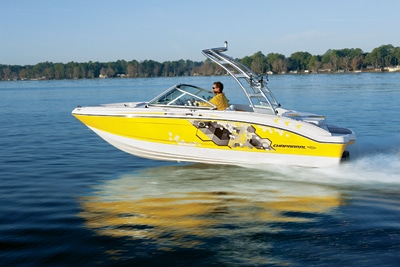
Round 3: Performance
In terms of performance, each type of propulsion has its strengths and weaknesses. With no appendage drag from a drive, no slip, less weight aft and the propulsion in a direct line, a jet typically exhibits quicker hole shot with less bow rise.
This contention was reinforced by our testing, although with only a single engine to work with(see “Twin It to Win It?”), the advantage was not as dramatic as we’ve seen on twin-engine jets. With its single 255 hp supercharged engine, the Sea-Doo planed in 4.1 seconds; with its 220 hp sterndrive, the Chaparral required 4.25 seconds. As expected, the jet achieved plane with slightly less bow rise. The Sea-Doo also enjoyed an edge to 30 mph, covering the gap in 7.6 seconds to the Chaparral’s 7.96 seconds.
Once on plane, the sterndrive shines. Its ability to trim reduces the wetted surface of the hull and produces a more optimal running angle, reducing resistance, increasing efficiency and resulting in a softer ride in rough conditions. Despite a 35 hp disadvantage, the Chaparral peaked at 51.4 mph. The Sea-Doo topped out nearly 8 mph slower, posting 43.7 mph.
Fuel economy? At 25 mph, the jet burned 8 gph for 3.1 mpg, while the sterndrive consumed 4.7 gph, netting 5.3 mpg. Above 40 mph, the Sea-Doo consumed 16 gph, the Chaparral under 11 gph. At full throttle both consumed 19.5 gph, but the Chaparral ran nearly 8 mph faster, boosting its economy.
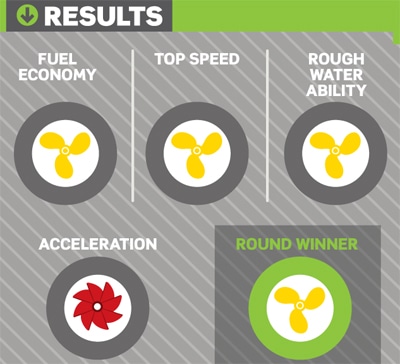
Twin It to Win It?
While we tested a single-engine jet versus a single-engine sterndrive, this comparison is not indicative of what’s occurring in the market. Twins have long been more popular in jet boats, for their brutal power delivery, almost nonexistent bow rise and ability to reach higher top speeds. Naturally, twins cost more to buy and own.
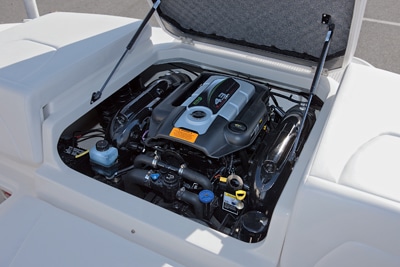
Round 4: Ownership Issues
In terms of maintenance, there are fewer moving parts in the jet propulsion setup. Once the drive shaft leaves the engine, it directly spins the impeller. A sterndrive has additional gears housed within a lower unit that involve more moving parts and result in more vulnerability to damage.
It’s hard to predict what may happen to any given engine, but we can look at scheduled maintenance costs. For sterndrives, MerCruiser recommends an initial service after a 20-hour break-in period, including an inspection along with an oil and filter change (about $120). An annual — or 100-hour — service includes the oil and filter changes plus changing the gear lube, replacing the fuel filter and cleaning the flame arrester and crankcase ventilation hoses. Typical dealer price runs about $500 to $600.
Sea-Doo suggests an initial 10-hour inspection, including an oil and filter change, for about $110, and then 100-hour (or seasonal) oil and filter changes, lubrication of key components, coolant flush and, on supercharged models, a supercharger rebuild. The basic service is about $200; a supercharger rebuild can add $500 to the total. On sterndrive engines, the biggest potential repair is likely the water pump impeller, for around $150.
Winterization on a sterndrive includes draining the raw-water portion of the cooling system and filling with antifreeze, fogging the engine, stabilizing the fuel and changing drive-gear lubricant. Service runs in the neighborhood of $300. Winterization on a jet involves fuel additives, blowing-out of the water lines, engine fogging and battery maintenance and typically costs about $200. It’s important to note that many dealers suggest doing more on both engine types used in salt water, and dealer prices can vary.
It’s not a good idea to keep either engine type docked in salt water long term without a lift. In these conditions the jet will suffer most, with corrosion and aquatic growth wreaking havoc on the jet pump’s tight impeller clearance tolerances. It’s also notable that parts and service facilities for sterndrives are more numerous.

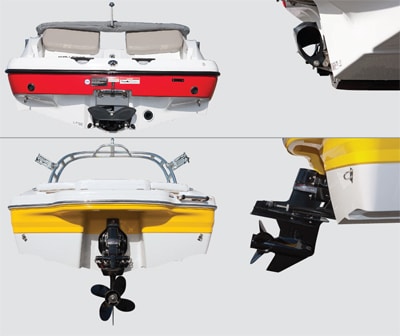
Round 5: Safety
An oft-touted selling point of jet drives is safety. With the impeller completely enclosed, jets present no whirling blades that could impact a swimmer or skier, nor any exposed hardware that hangs beyond or below the confines of the hull. In contrast, a sterndrive features an exposed propeller, as well as the drive itself, that could cause injury at the hands of a careless captain. Sterndrive manufacturers have attempted to lessen the prop’s exposure in recent years with extended swim platforms that distance swimmers from the prop, but this issue is relatively clear. The jet offers a safety advantage over a prop, especially with an inexperienced skipper at the helm.
That same pump configuration also equates to far less draft and running gear that might be damaged by a strike with an underwater object. The Sea-Doo features a maximum draft of 12 inches, the Chaparral as much as 31 inches. The sterndrive can be trimmed, lessening that to as little as 13 inches.
But in shallow waters as a jet pulls water into the pump for propulsion, it can also suck up stones, weeds or debris. A protective grate prevents large objects from entering the pump cavity, but smaller objects can enter and create problems. The sterndrive is clearly superior in weedy areas. A jet has the potential to clog in weeds and needs to be cleared. Savvy boaters will shut the engine off quickly and allow debris to float away. Rarely will a boater have to swim below and manually clear the grate. Optional solutions include Sea-Doo’s electronic drop-down grate and Yamaha jet boats’ pump clean-out ports that allow access from the swim platform.

Final Results: Win, Lose…or Draw
So is there a clear winner in this comparison? Clearly no. Each type of propulsion has advantages over the other, and each has its weaknesses. Some you may have expected, while others surprised even us. Those positives and negatives are likely amplified by your experience, the environment in which you boat and what you ask of a boat. In that regard, only you can take the sea trials and make the call.
The power of choice is a win for all boaters.
